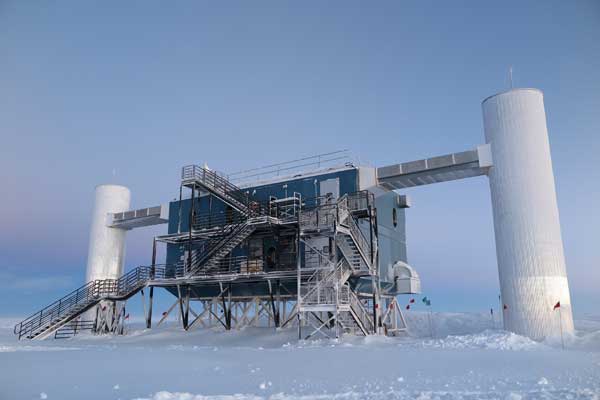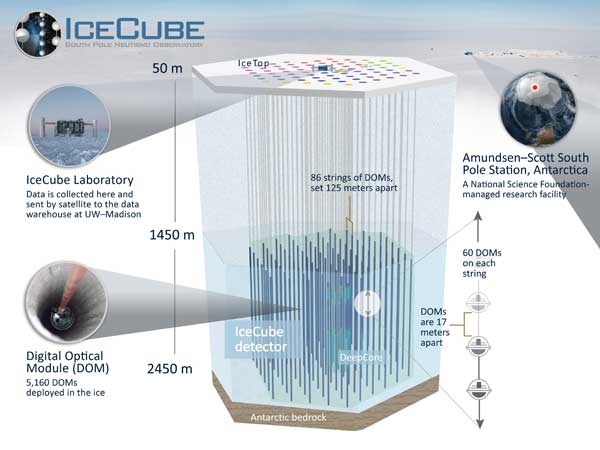The Antarctic observatory known as IceCube has ruled out the existence of a fourth type of neutrino particle — and one-time dark matter contender — known as the light sterile neutrino.

University of Wisconsin
Neutrinos are among the smallest subatomic particles, less than a millionth the mass of an electron. They’re among the most antisocial too, interacting only rarely with other particles. Every second, 100 trillion neutrinos pass through your body without bothering you a bit.
In fact, with characteristics like these, neutrinos actually qualify as elusive dark matter, the invisible stuff that suffuses the universe and governs its fate. But they don’t account for much of it. We know of three neutrino types (muon, tau, and electron), and they’re all too light and speedy to account for more than a pittance of the universe’s missing mass.
For years now, though, physicists have had reasons to suspect that a fourth, heavier type of neutrino might exist, perhaps even in sufficient quantity to explain all the universe’s missing mass. This fourth neutrino, often called a sterile neutrino, would be markedly different than its brethren: it would eschew the weak nuclear force, the fundamental force of nature by which the other three types exert occasional influence on ordinary matter. Instead, it would opt for solely gravitational interactions.
Some experiments had caught hints of a “light” sterile neutrino, about three times the mass of the other neutrino types combined. Neutrino detectors, nuclear power reactors, and radioactive sources had all produced anomalies that theorists said a light sterile neutrino could explain. But bona fide detections remained out of reach.
“Like Elvis, people see hints of the sterile neutrino everywhere,” IceCube principal investigator Francis Halzen (University of Wisconsin) said in a press release. “There was this collection of hints, and theorists were convinced it exists.”
Astrophysics diverged from physics, though. The Planck satellite’s observations of the cosmic microwave background (the Big Bang’s afterglow) were consistent with only three types of neutrinos. If a fourth neutrino existed, scientists would have to rethink their analysis of the earliest light in the universe.
Now, a recent study in Physical Review Letters has left the light sterile neutrino out in the cold.
Light Sterile Neutrino Bites the Dust

University of Wisconsin
The IceCube Neutrino Observatory consists of 5,160 light sensors deep within a cubic kilometer of ice in Antarctica. Out of the billions and billions of neutrinos that pass through Earth every second, rare interactions with ordinary matter generate occasional flashes of light. Over a year’s worth of looking, IceCube scientists caught hundreds of thousands of flashes — that is, hundreds of thousands of neutrinos that had passed through space and the bulk of Earth, only to be caught in Antarctic ice.
Neutrinos are changeable creatures, constantly morphing from one type to another. A muon neutrino, for example, can change without warning into a tau neutrino or an electron neutrino. All of these might rarely interact with ordinary matter to generate light that IceCube can see. But a muon neutrino might morph instead into a sterile neutrino, which won’t interact with the ice atoms. The presence of sterile neutrinos would therefore show up not as a signal but as an absence of neutrinos at a particular energy. Rather than flashing light at IceCube, sterile neutrinos would pass quietly through Earth and back into space.
IceCube saw no sign of this absence — neutrinos produced the expected signals over an energy range that spanned 320 billion electron volts to 20 trillion electron volts. As a result, Halzen and colleagues have effectively ruled out the existence of a light sterile neutrino, which in turn removes one of the (many) contenders for dark matter.
Watch the IceCube team explain the results:
Not the End of the Story
Lest you think sterile neutrinos are out of the running — they’re not. The recent IceCube study was looking specifically for light sterile neutrinos, but heavy sterile neutrinos (those with masses of more than 10 eV) are still a possibility. Planck, too, leaves open the possibility of heavy sterile neutrinos. A strange X-ray signal seen in observations of galaxy clusters might yet be explained by a heavy sterile neutrino with a mass of 7,000 electron volts.
The IceCube results do, however, put to death hopes raised by many physics experiments that had seen hints of a light sterile neutrino with a mass around 1 eV. Those hints can now be ruled out as statistical anomalies.
That said, physicists are still working on closing loopholes. “While the IceCube search puts strong limits on light sterile neutrinos, combined analysis of many experimental data are indicating small remaining allowed regions,” says David Schmitz (University of Chicago). Schmitz, who wrote an accompanying reaction piece online in Physics, is planning follow-up analysis to detect not just neutrino disappearances but appearances as well.
Read S&T Contributing Editor Govert Schilling's award-winning article on the IceCube observatory in the January 2014 issue of Sky & Telescope.
 0
0









Comments
You must be logged in to post a comment.